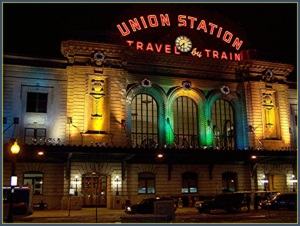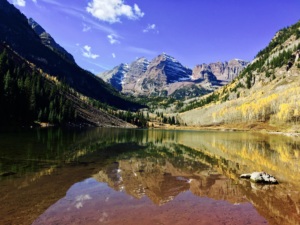Taran Volckhausen
Former Communications Associate, The Public Interest Network
The entire month of August, Colorado’s public transit service will be free to ride. This guide will help you get out and enjoy Colorado’s beautiful natural scenery by providing the basics on the public transportation options to get around the state without using a car.
Former Communications Associate, The Public Interest Network
To tackle deteriorating air quality, Colorado passed Senate Bill 22-180. The bill funds a month of fare-free transit, in partnership with the Colorado Energy Office, in an attempt to get people out of their cars and onto public buses. Throughout the entire month of August, riders don’t need to pay anything to ride Regional Transportation District (RTD) buses, which serve cities and towns up and down the Front Range. If you want to travel even farther, Colorado Department of Transportation’s (CDOT) long-haul bus service Bustang has 50% discounted fares until September 5.This guide will help you get out and enjoy Colorado’s beautiful natural scenery by providing the basics on the public transportation options to get around the state without using a car.
Union Station
If you fly into Denver, you can take the train to Union Station downtown. The A Line leaves the Denver International Airport (DIA) every 15 minutes. Once you get to Union Station, you’re connected to rail, rapid bus transit and local routes throughout Denver. This transportation hub also connects you to many public transit lines that can get you up to beautiful hiking trails in the foothills and mountains.

Union Station is a hub for public transportation including trains to the airport, which are free for the month of August.Photo by Loco Steve
Denver to Boulder
One good option for visiting the mountains is to catch the Flatiron Flyer from Union Station to Boulder, Colorado. The small city nestles up against the foothills of the Rocky Mountains. The west side of Boulder is known for its distinctive, craggy rock formations, the Flatirons, which are easily accessible from trails.
If you come on the weekends, you can take the Flatiron Flyer from Denver to Boulder, and then easily hop on a free shuttle service to Chautauqua Park at the base of the Flatirons. The shuttle runs in two directions: one from the New Vista High School near the Flatiron Flyer’s Baseline and Broadway stop; the other leaves from the downtown Boulder RTD Bus Station. The shuttle leaves every 15 minutes between 8:00 a.m. and 8:00 p.m. on summer weekends and holidays.
Boulder has good pedestrian infrastructure and so even if you come on a weekday, you can access trails without a car. For example, it’s a pleasant walk from the bus station along the Boulder Creek Path to Eben G. Fine park, which will get you close to Boulder’s little Red Rocks (not to be confused with the famous Red Rocks Amphitheatre in Morrison). Or if you have 30 or 40 minutes, you could walk up to Chautauqua Park from Baseline and Broadway or downtown Boulder.
Boulder to Nederland
The Boulder Transit Station connects you to the high mountains through Nederland, Colorado. Hop on the NB route to ride up Boulder Canyon. After 45 or so minutes, you’ll arrive at the end of the bus line at Nederland High School. From May 27 to October 9, 2022, you can take the Hessie Trailhead Shuttle on Fridays and weekends to the Hessie trailhead. The bus leaves approximately every 15 minutes. As an added bonus, the Nederland bus is free whenever the Hessie Trailhead Shuttle is running – even after the month of August.
RTD buses all have bike racks on the front and the regional buses can put bikes down below. It’s a great option for those who want to mountain bike without paying any money!
Denver to Golden
From Union Station, you have the option to grab the RTD W-Line light rail to Golden, Colorado. You’ll take the train to the end of the line, where it will drop you off at the Jefferson County Government Center/Golden Station. Here you can catch the Golden FlexRide bus, which leaves once per hour and can get you to the Clear Creek Canyon Park Gateway Trailhead with access to gentle hiking trails up Clear Creek Canyon.
Bustang
This is an intercity bus service that connects Denver, Colorado Springs, Fort Collins, Glenwood Springs, Grand Junction, Gunnison and Durango – all great cities and towns for enjoying the great outdoors. For many of these destinations, it may be a good idea to bring a bike (the Bustang has a bike rack) to help you get to trailheads.
Heading south from Denver will get you to Colorado Springs. Once you get to Colorado’s second largest city, you can use the Mountain Metro Bus to get to nearby Manitou Springs. From here, you can hop on a free shuttle to get to the Manitou Incline or the Barr Trailhead or The Cog Railway — the latter two lead to the summit of Pikes Peak.
For the particularly intrepid explorer, you can head southwest to the start of the Colorado Trail in Durango. Conceivably, you could take the bus to Durango and get all the way back to Denver without stepping foot in an automobile. For a more family-friendly option, you may choose to hop on the Silverton Narrow Gauge Railroad to recreate the “Golden Age” of our nation’s railroads as you cross through the rugged and beautiful San Juan National Forest.
Taking the Bustang to Glenwood Springs (you could also take the Amtrak train) will get you close to Aspen and the Maroon Bells mountains. Once you get to Glenwood Springs, you can catch the Roaring Fork Transportation Authority (RFTA), which will take you to Aspen. There you can get on the Maroon Bells Shuttle Bus, which runs every 15 minutes. You will need to make a reservation with the Aspen Chamber of Commerce (tickets are $16 for adults and $10 for children).

The Maroon Bells, outside of Aspen, are one of many destinations hikers and bikers can reach via public transit.Photo by RyanFSpack, CC0, via Wikimedia Commons | Public Domain
After clearing mind and body in the mountains, advocate for clean air on the Front Range
As you can see, we have options to get to the mountains without using a private car. Colorado, however, still needs to invest in better, cleaner travel options — and more of them. We can’t afford dozens of dirty air days year after year that contribute to asthma and other diseases, and force many people inside. To reduce dangerous ozone pollution, CoPIRG is advocating for a comprehensive statewide plan to expand clean travel options, among other clean air initiatives.
Take action and tell our state leaders to increase funding for clean transportation infrastructure.
Former Communications Associate, The Public Interest Network